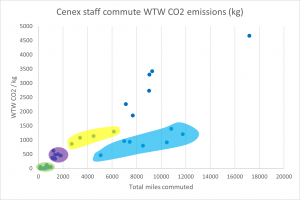
- Category:
- News
What can you save by working from home?
Commuting by car is costly and often a stressful experience.
Congestion costs time and money, but more significantly right now, it also costs the environment as combustion engine exhausts emit pollutants into the atmosphere.
The environmental impact of commuting can be reduced in two main ways – choosing a lower emission option or travelling less (less distance or less often).
One of the few silver linings of the coronavirus pandemic is that the guidance to work from home where possible has enforced the latter of those two options and led to a reduction in the number of car journeys taken and a drop in air pollution levels.
Research by O2 found that nearly half (46%) of UK workers are concerned about the negative environmental impact of the daily commute to work– with a third (39%) actively wanting to reduce the number of times they travel for work.
If full-time UK workers (who are able to work remotely) work from home for just one day per week, there would be a reduction of 1,526 miles travelled each year and £449.70 of annual savings per person, resulting in an annual 7.1 megatonne CO2e decrease of greenhouse gas emissions.
By working from home permanently from the 16th March up until the beginning of England’s second lockdown on 4th November, the 33 Cenex employees based at the Loughborough office have saved a total of 4,076 trips and 115,106 miles of travel, contributing an estimated saving of: 24,085 kg of CO2 (WTW), 32,145 g of NOx and 622 g of particulate matter so far (and more as we continue to work from home).
Prior to the lockdown, the average commuting distance for employees at Cenex came in at 33 miles, more than double the national average (14 miles) with the majority (82.2%) of journeys made by car – again higher than the national (68%) and regional (79%) average – Cenex attracts employees from across the East Midlands and its proximity to the major road networks makes car travel an easy choice.
Calculating the well-to-wheel CO2 emissions of Cenex staff prior to the first national lockdown as an example, we can roughly group people into one of six groups, and those looking to reduce their environmental impact should aim to move to the bottom of the chart to contribute as little CO2 as possible.
As an organisation that works to lower emissions from transport, employees try to reflect the same values in their personal lifestyle choices: as such the split between low & zero emission commuting methods and traditional cars is 48% to 52%.
More individuals shifting to lower emitting options will reduce the environmental impact, however there are many other factors at play, including price, convenience, and journey time.
In a company survey, Cenex staff highlighted the cost and chargepoint access (predominantly for on-street parking) as the main reasons for not adopting personal electric vehicles.
The same survey revealed that the majority of Cenex staff are not happy about the environmental impact of their commute or their general travel, whereas around a third of colleagues are either content or completely convinced that the impact of their commute is as low as it can be.
Communicating the attitudes and values of employees, and reflecting these in the options available to them, can go a long way to reducing stress, improving welfare, and minimising your organisation’s environmental impact.
Given the difficulties of moving house or jobs to be closer to work, and the barriers to choosing lower emission alternatives, travelling less frequently by working remotely can help us all reduce our environmental impact.
Cenex is working with local authorities to enable the public to access widespread sustainable transport, including policies and infrastructure for electric car, bike and scooter share schemes.
While the commute to work only makes up a small proportion of transport’s emissions, every saving is a step in the right direction towards net zero.
Get in touch to see how you can lower your emissions
